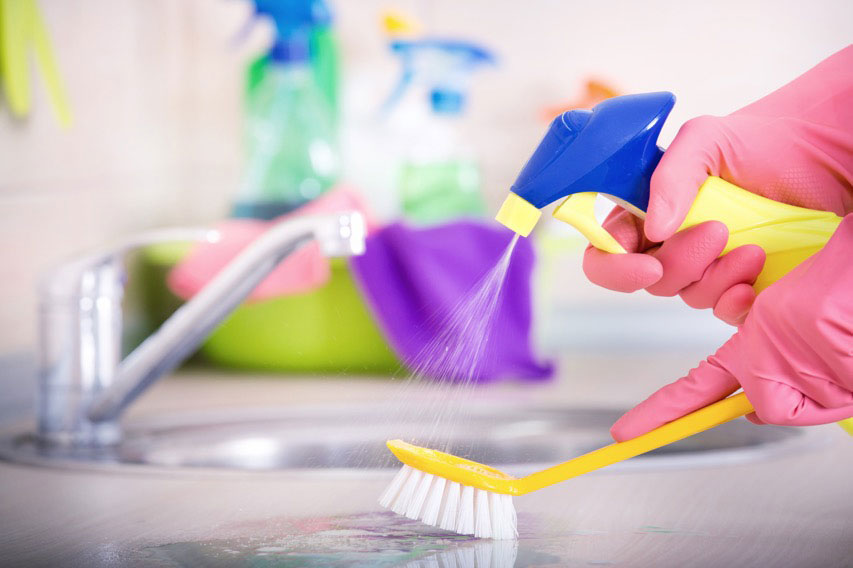
The Benefits of Pet-Safe Cleaning Supplies
When it comes to pets and cleaning, you probably thought the scariest thing in your house was the vacuum cleaner—your pup runs and hides every time it comes out, right? But the truth is that the most potentially dangerous things in your home are actually found in the cleaning supply cabinet. In fact, your regular cleaning products could be toxic to your pets and expose them to harmful substances that could threaten their health for the long-term. But are there actual benefits of switching to products marked as “pet-safe?” Let’s take a look.
BEFORE YOU BUY: Make sure that you keep a copy of the ASPCA’s list of poisonous household products somewhere that’s easy to access, like on the fridge or saved as a bookmark on your phone. While you’re at it, record the number for the ASPCA Poison Control Center: (888) 426-4435.
What Are Pet-Safe Cleaning Supplies?
Pet-safe cleaning supplies are household cleaners, including floor cleaning products, laundry detergents, window cleaners, drain cleaners, polishes, soaps, and all-purpose cleaners that don’t include certain ingredients that are thought or proven to be harmful to animals. Some cleaners contain toxic or irritating chemicals that could be dangerous if they are ingested, inhaled, or come into contact with your pet’s skin. Those who have pets in their home or business should be cautious of using cleaning products deemed dangerous to animals.
How Do I Know if a Product Is Pet-Safe?
There is no official designation, certification, or seal to determine whether or not a household cleaner is pet-safe, but choosing products that use ingredients and formulas that are EPA Safer Choice Certified or Green Seal Certified is a step in the right direction. The best thing you can do is to know what to look for in a product before you expose it to your pets. Rather than checking to see if every detergent, cleaner, or polish in your home is pet-safe, it helps to know which cleaning supply ingredients are toxic or dangerous to dogs. Here’s a quick list of what to avoid:
- Ammonia—This common household cleaner, found in window cleaners, oven cleaners, stainless steel cleaners, hardwood floor waxes, and many other products, is listed on the Agency for Toxic Substances and Disease Registry (ATSDR) database and can cause respiratory issues, including burning and trouble breathing, and it may irritate your pet’s skin and eyes.
- Bleach—Sadly, one of the most effective household cleaners is also one of the worst for our furry friends. Bleach can be used to clean toys and surfaces in a well-ventilated space when it’s properly diluted, but if your pet swallows it in concentrated form, it could cause vomiting, burns, diarrhea, respiratory illnesses, and even seizures.
- Phthalates—Typically used in air fresheners, deodorizers, and other scented cleaning products, phthalates are chemicals that are added to cleaning formulas to make them smell good. Studies show that phthalates may be carcinogenic for animals and humans, so it’s best to avoid products labeled as containing “fragrance.”
- Other Ingredients to Avoid—You should also look for cleaning products that don’t contain formaldehyde, glycol ethers, dioxane, perchloroethylene, or phenols. If you’re not sure if your cleaning product is safe, be sure to talk with your veterinarian or consult the ATSDR’s Substance Priority List.

Why Switch to Pet-Safe Cleaners?
At the end of the day, the primary reason why you want to rid your household of potentially dangerous cleaners is because it will help you rest easy. You’ll feel that you’re doing the best you can to prevent your family members from being exposed to products that could cause immediate or long-term health problems. Here is a quick list of reasons for why you should make the switch now:
- They’re Better for the Family—As you can see, certain cleaners may work well, but they come at the cost of the health of you and your pets. According to the ASPCA, exposure or ingestion of cleaning supplies was the fifth most-cited reason for calling animal poison control, after prescription medications, over-the-counter medications, food, and veterinary products. These harmful substances aren’t just bad for your four-legged pals. The National Poison Control Center reports that cleaning substances are the second most-common category in pediatric poison exposure, accounting for 11.1 percent of poison control cases.
- They’re Better for the Environment—It just so happens that many of the toxic substances listed above are also volatile organic compounds (VOCs), meaning they emit dangerous or harmful chemicals into the environment and our ecosystem. These compounds are the primary foundation for ozone and particulate matter, which forms smog and compromises our air quality. Bleach and ammonia are two of the most common VOCs found in the cleaning supply aisle. For these reasons, be sure to use pet-safe and green cleaning supplies.
- Other Cleaners May Soon Be Outlawed—In recent years, the Environmental Protection Agency (EPA) has cracked down significantly on certain compounds found in household and commercial cleaners, with the agency working on initiatives to regulate, limit, or outright ban many of the most common ingredients found in the cleaning supply closet. The fact of the matter is, you should get used to adjusting to gentler cleaners, as they’ll probably be all that’s left at some point!
Making the Switch
If you aren’t quite ready to purge the cabinet under the sink, be sure that you’re properly diluting any concentrated formulas, using locking or childproof cabinets for storage, and putting lids or caps back on the bottle properly. Never leave out any cleaning supplies that contain harmful substances, especially at a level where your pet can reach. Our best advice is, once your current supply of potentially toxic products runs out, replace them with safer options and never look back!










